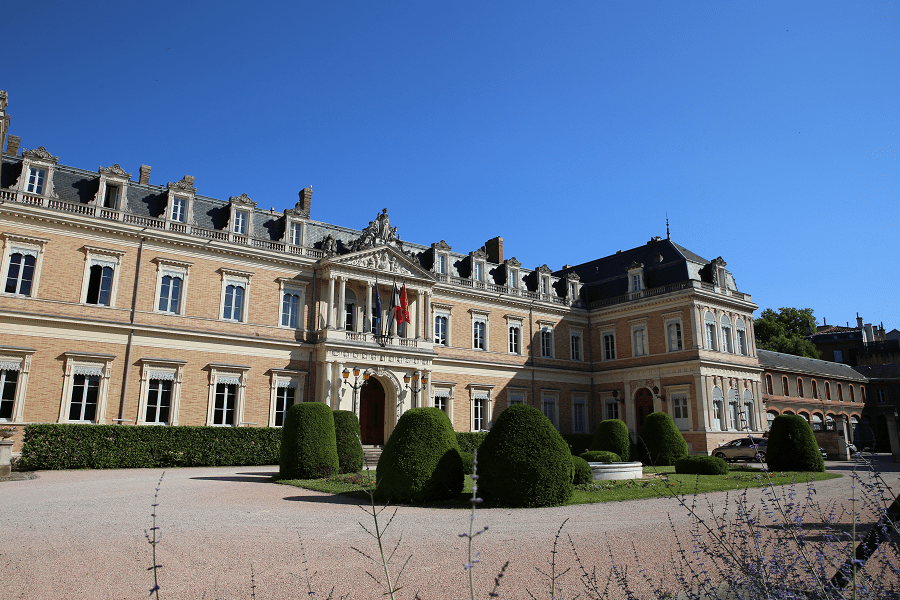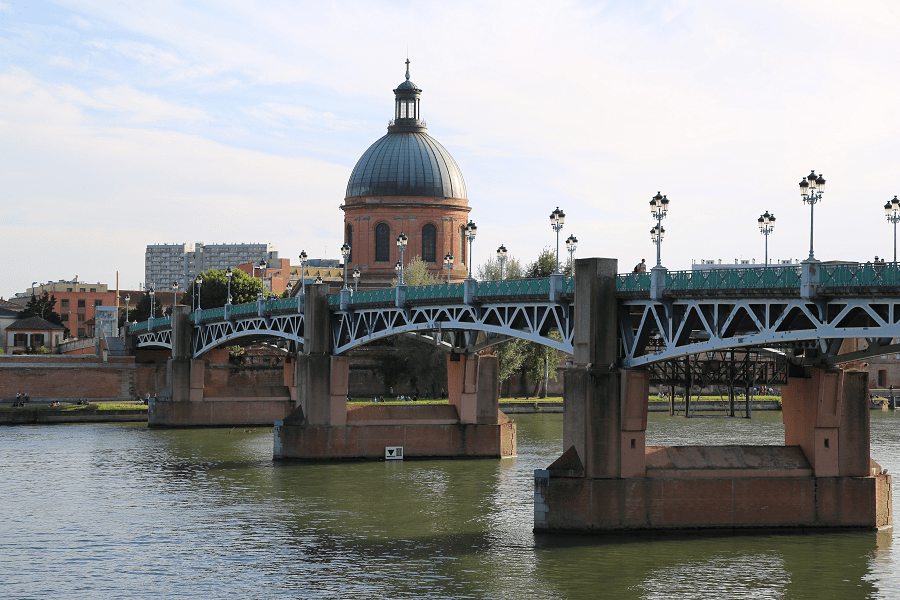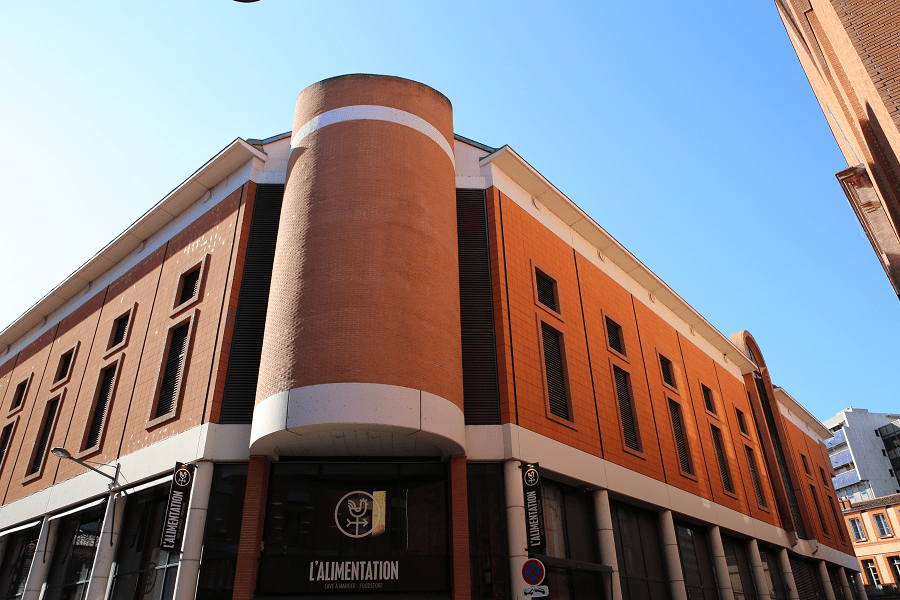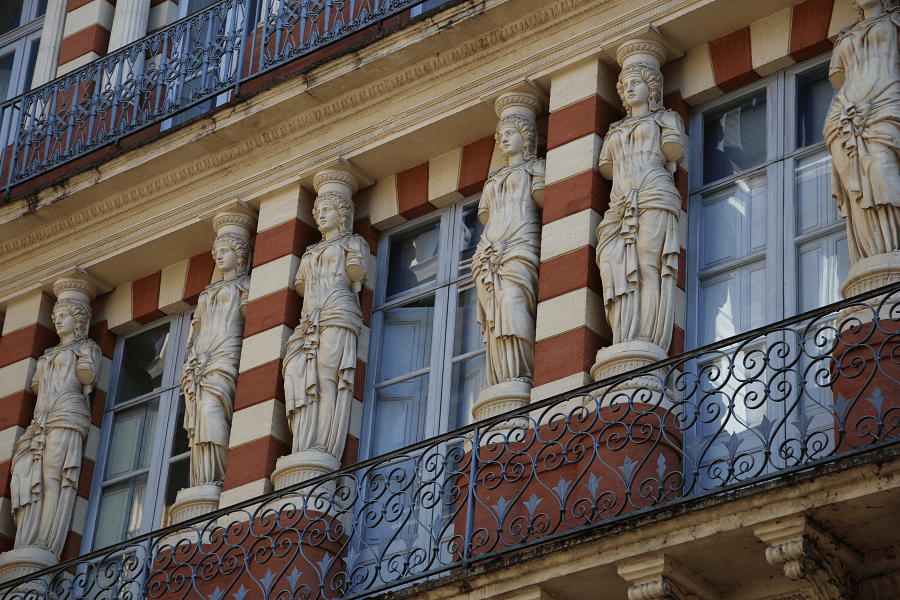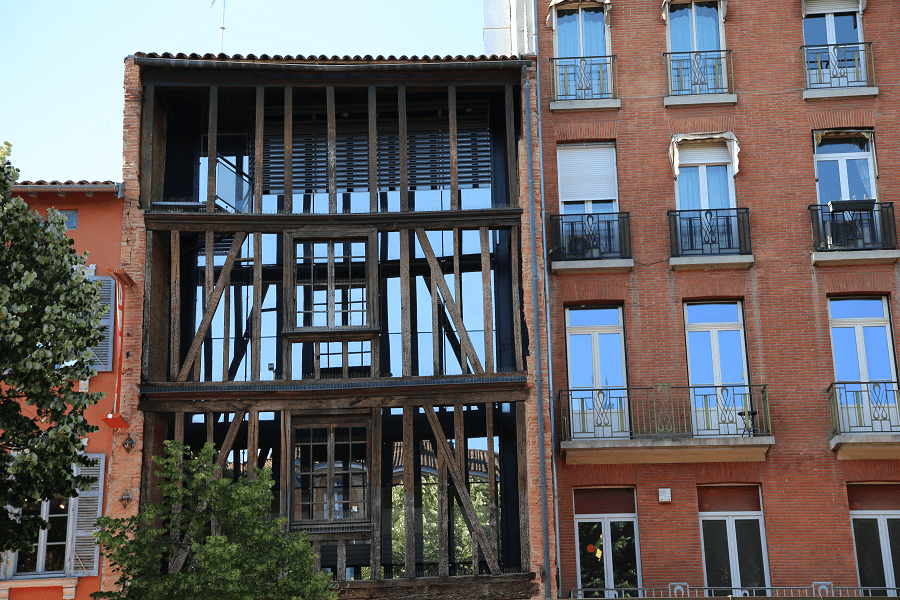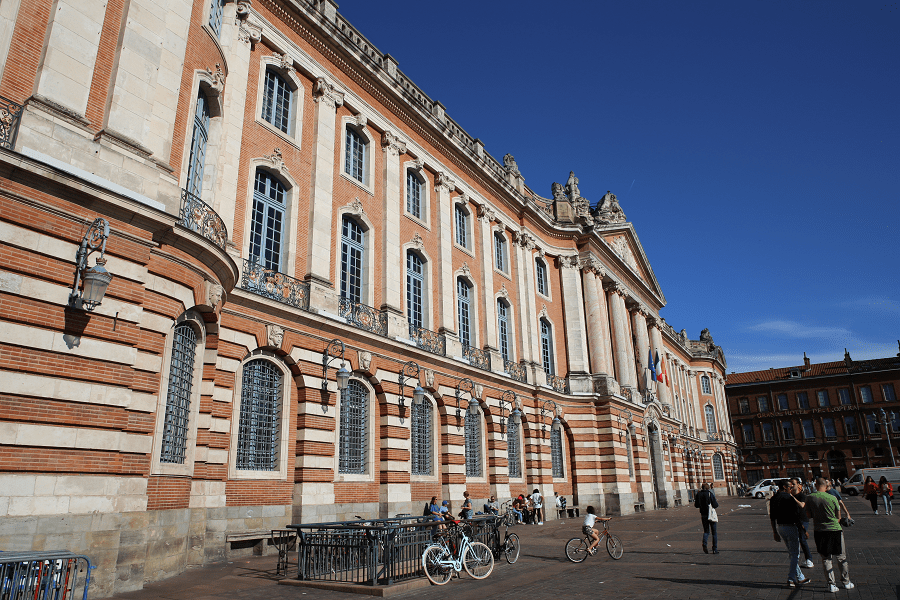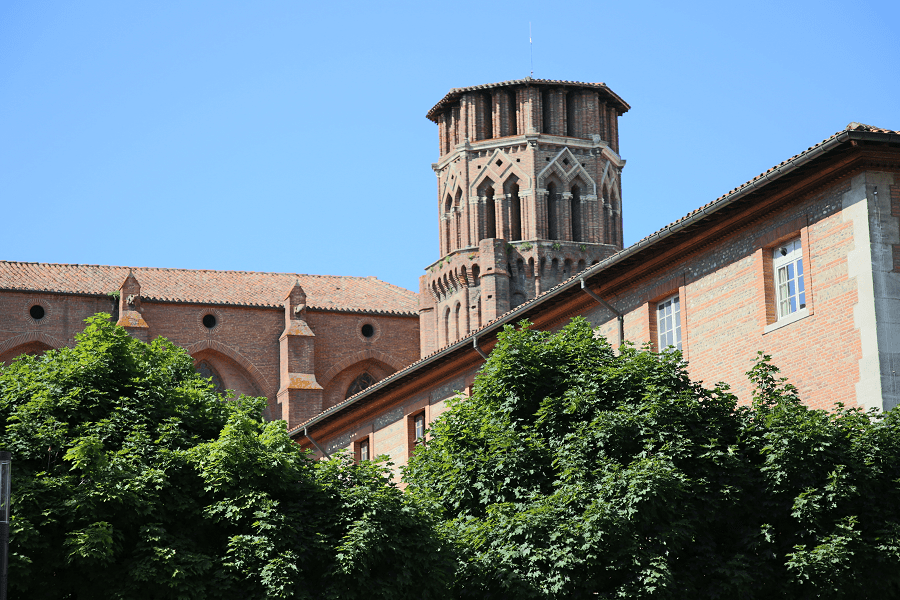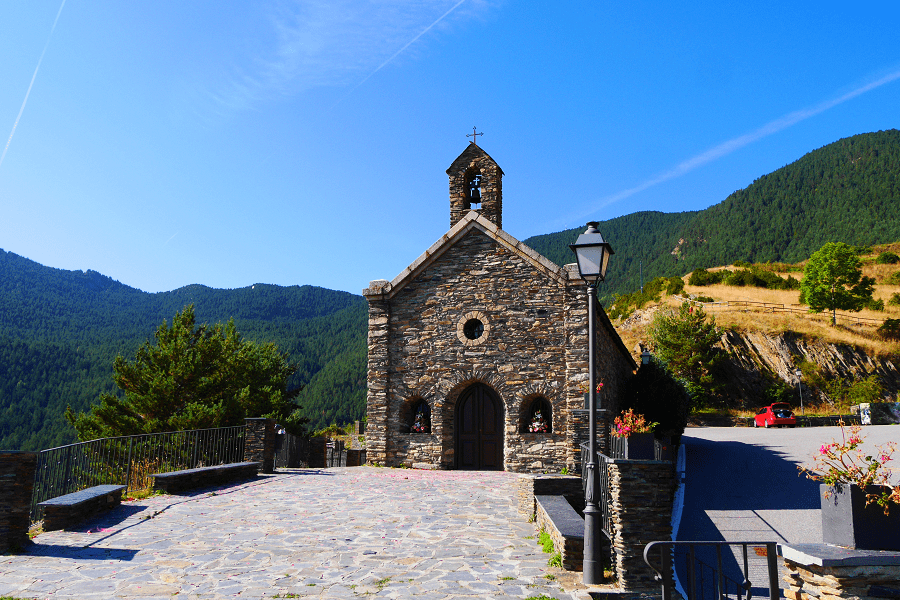Toulouse is a commune in southwest France in Occitania (being a capital of it), divided in half by the Garonne River and located about 200 km from the border with Spain (Pyrenees).
The violet culture development in the nineteenth century led the French to choose this flower as the city’s emblem, and the city itself earned its “pink city” name.
Toulouse has historically been the capital of the Visigoth kingdom, an early feudal state entity and, historically, the first of the so-called “barbarian kingdoms” that developed on the territory of the western Roman Empire during its collapse in the 5th century. The capitals were Barcelona, Toulouse, Toledo, Narbonne and Languedoc.
Toulouse is the capital of the Occitan’s Haute-Garonne department and the Toulouse metropolis headquarters, which unites part of the Toulouse agglomeration in Haute-Garonne and has 37 municipalities today.
Toulouse is France’s fourth most populous municipality (after Paris, Marseille and Lyon). About 1.4 million residents lived in the municipality in 2021.
City History
The Gallic people’s confederation occupied west Languedoc from the middle of the third century BC – long before the Roman settlement; there is the belief that they were the first settlers of Old Toulouse, which was located several kilometers to the south from modern Toulouse. Local settlers had trade relations with Spain, Italy and the rest of Gaul; they exchanged wine, wheat, leather and metal products.
The Romans conquered Toulouse (Tolosa in Latin) in 107 BC. There, as in other large cities, the Gallo-Romans built aqueducts, baths and an amphitheater. They surrounded the city with a huge brick wall; some parts still remain.
The city rapidly grew and flourished; the first Saint Sernin Basilica was built in 403 AD, due to the increase in the number of Christians in the region.
However, because the city was far from the Mediterranean Sea, it was not the most influential in the region.
The “ephemeral” Toulouse Kingdom was established in 629 AD; then, in the seventh and eighth centuries, the city became the capital of the Grand Duchy, which stretched from the Pyrenees to the Loire and from Rodez to the Ocean (l’Océan).
In 721 AD, the Arab army besieged the city; finally, on June 9th, 721, they defeated their rivals at the Battle of Toulouse, which marked the end of the army’s advance to the north.
In the Middle Ages, the city remained independent for a long period of time, and the counts of Toulouse spread their possessions to most of the south of France.
In 1096, Pope Urban II (leader of the First Crusade) went to Toulouse to consecrate the basilica of Saint-Sernin.
The first general council was created in 1152; it was the court prototype. The council collected taxes, held trials and maintained order in the city.
The Capitol appeared at the northern gate in 1190; nowadays it is the city’s symbol. Also, one of the first joint-stock companies appeared at the same time: the Bazacle mill on the Garonne River.
The Catharism became the start for the Albigensian crusade in 1209.
The Treaty of Paris (le traité de Paris), which ended the Albigensian conflict between the King of France and the Count of Toulouse – and marked the final accession of Occitan countries to the royal estate of Les Capétiens – was signed on April 12th, 1229.
The University of Toulouse was founded the same year.
The county became part of the Languedoc French kingdom in 1271.
Dominique de Guzmán (Catholic priest canonized, in 1234, by the church as Saint Dominic) founded the order of preaching “Dominican brothers” in 1215 to counter the influence of the “the Cathars heresy.”
The city became the fourth of the kingdom of France in the 14th century; however, in 1348, the city was decimated by the Black Death, which continually recurred in the 14th and 15th centuries. The city was also robbed during the Hundred Years War.
In the Renaissance, Toulouse experienced a period of great prosperity (from the late fifteenth to sixteenth centuries), and large mansions, such as the Bernuy Hotel and the Assézat Hotel, were constructed.
On May 7th, 1463, a terrible fire occurred, destroying three-quarters of the city and several churches and monasteries.
On December 23rd, 1468, King Louis XI decided to restore Toulouses’s Parliament and court, as their powers had previously been transferred to Montpellier.
Toulouse was the fourth city in France where printing began (the year 1476).
Protestants and Catholics entered into bloody battles in 1560.
Catholics defeated the Huguenots and looted their homes during the riots in 1562.
Catholicism was victorious in the seventeenth century, and many monasteries were established.
Two symbols of the city, Pont-Neuf and Canal du Midi, were created in 1632 and 1682, respectively.
The Capitholium was rebuilt in the 18th century.
Toulouse accepted the French bourgeois revolution; there are records showing several robberies and attacks on castles. Conflicts erupted in the late 18th century, due to church reform. The city lost the regional capital title and became the Upper Garonne’s main city.
The Jacobins managed to keep it from the federalists’ uprising (which avoided the connection of the west with the southeast). The Republicans managed to defeat the popular uprising in exactly the same way as they did in 1799; the main motive of the uprising was the refusal to take part in compulsory military service.
The Battle of Toulouse took place on April 10th, 1814; it was the last Franco-British battle on French soil.
The railroad reached Toulouse in 1856.
A severe flood occurred in Toulouse on June 23rd, 1875. The Garonne climbed to 9.47 m, flooding almost the entire left bank and destroying most of the bridges. Two hundred and eight people were killed, more than 1200 houses were destroyed and about 25,000 people were left homeless.
Tourism, sights, architecture and major attractions
Toulouse’s architecture is typical for the South of France. People call Toulouse the “pink city” because of the traditional local building material’s color – the terracotta brick.
The main city attraction is the Saint-Sernin Basilica (La Basilique Saint-Sernin), built to bury the relics of St. Saturninus, the first bishop (and great martyr) of Toulouse. Toulouse was one of the most important pilgrimage centers of the medieval West from the 9th century until the French Revolution.
Saint Saturninus led the Christian community of Toulouse. He did not abandon Christianity, contrary to the requirements of the Gentiles, who tied him with a rope to a bull that dragged him around the city. The rope broke in the place where the Basilica stands today; however, this did not save St. Saturnin, since death had already come. Two nuns buried him in the same place. The Basilica is also a symbol of Southern Romanesque architecture.
Capitole Theater (Le Théâtre du Capitole) is a public institution that has been under municipal control since 1994. Dedicated to lyric art and ballet, the theater is located on the Toulouse Capitol territory. Opened on October 1st, 181 – on the site of the old theater erected by the Capitals in 1736 – the theater has 1,156 seats in the largest Italian hall today. The Capitol Theater is a member of the ROF (the lyrical theater’s association of France, created in 1964, which promotes the development of opera in its historical, cultural, institutional and political context), RESEO (the European network of institutions for the popularization of opera and dance) and Opera Europa (an international service organization for professional opera companies and opera festivals in Europe). There is also the Halle aux Grains in the city center; it is a symphony concert hall, where the National Orchestra of the Toulouse Capitol performs.
Sorano Theater (le Théâtre Sorano), created in 1964 by Maurice Sarrazin in the former auditorium of the Natural History Museum of Toulouse (Muséum d’Histoire Naturelle de Toulouse), houses a drama center founded by Charles Dullin in 1945. Its name is a tribute to Daniel Sorano, a famous Toulouse actor and friend of Maurice Sarrazin. The theater’s capacity is 430 spectators, and its focus is on creative intelligentsia and youth.
The Théâtre de la Cité, the former National Theater of Toulouse, is a national drama center located in the heart of the historic center between Wilson Square (La Place Wilson) and Occitane Square (La Place Occitane). The theater receives up to 100,000 spectators per year.
Among modern cultural and business places is the Congress Center Pierre-Baudis (le center des congrès Pierre-Baudis), named after Pierre Bodis, mayor of Toulouse (1971-1983) and the media library Jose Cabanis (la médiathèque José-Cabanis), located in the Marengo area of the former Toulouse Veterinary School (which was demolished in 1965). The Jean-Pierre Buffi architectural firm developed this monumental work. The Media Library has been open since 2004.
Zénith Toulouse Métropole Show Arena opened on April 17th, 1999, and its capacity is 11,000 spectators. The multi-functional arena is “flexible” and can adapt to any kind of show with the audience capacity.
The Museum of Natural History and Ethnology, located in the Botanical Garden of Toulouse, Busca-Montplaisir, houses collections of more than two and a half million coins in an area of about 6,000 m2. It is the second-largest in France after the Natural History National Museum (MNHN) in Paris.
Barrière Toulouse Casino, located on the Ramier Island (l’île du Ramier), is a complex that includes a concert hall with 1200 seats and a casino.
You can take a cruise along the Canal di Midi connecting the Garonne River and the Mediterranean Sea. There are also bicycle and pedestrian paths along the canal.
Toulouse is the European aeronautics and space industry capital
In the 1920s, Toulouse became an aviation pioneers’ city under the influence of Pierre-Georges Latécoère, who established air links with Casablanca and Dakar. Aéropostale (a transatlantic mail carrier) was established in 1927.
Former mechanic Emil Dewoitine took the pioneering steps in the aerospace field; he designed the first metal aircraft with a windshield. Soon thereafter, the state began supporting the Toulouse aviation industry.
Airbus and its parent company, Airbus Group, as well as the Space Research National Center (Center national d’études spatiales) are located there today.
An important attraction of Toulouse is the Space City (la Cité de l’espace). Opened in June 1997, it is a space-oriented center of science culture, dedicated to both astronomy and astronautics. Nearly five million people have visited the city during its 20 years of existence.
The city is a European “industrial field,” uniting many advanced industries: electronics, computer science, chemistry and medicine.
Toulouse also houses many medical research centers: Onkopol (oncology research campus, European Cancer Research Center), the National Institute of Health and Medical Research (INSERM, a French government-owned research and technology institution specialized in medical research, under the tutelage of the French Ministry of Higher Education, Research and Innovation and the French Ministry of Health) and the National Center for Scientific Research (CNRS).
Toulouse University is one of the oldest in France, along with the universities of Paris and Montpellier. French politician, Jean Jaurès, known for his pacifism and opposition to the outbreak of World War I, was a lecturer at the Faculty of Arts. Paul Sabatier, the famous French chemist and Nobel Laureate in chemistry in 1912, was the dean of the faculty of sciences and Vincent Auriol, president of the French Republic IV (1947-1954), had a doctorate in law. More than 100 thousand students study at the University of Toulouse today.
Toulouse and sport
Toulouse’s symbolic sport is rugby. Among the members of the Stade Toulousain sports club are outstanding athletes – both national and world level – who have won 20 titles of champions of France and 4 titles of champions of Europe.
Toulouse’s cuisine and restaurants
There are 26 Michelin list restaurants in the city:
- Py-r, 19 descente de la Halle-aux-Poissons, Toulouse, 31000, France, · Modern Cuisine (2 stars)
- Stéphane Tournié – Les Jardins de l’Opéra, 1 place du Capitole, Toulouse, 31000, France, · Modern Cuisine (1 star)
- Le Cénacle, La Cour des Consuls, 46 rue des Couteliers, Toulouse, 31000, France, · Modern Cuisine (1 star)
- Hedone, 2 impasse Saint-Félix, Toulouse, 31000, France, · Creative Cuisine (1 star)
- Michel Sarran, 21 boulevard Armand-Duportal, Toulouse, 31000, France, · Creative Cuisine (1 star)
- Chez Loustic, 19 rue Reclusane, Toulouse, 31000, France, · Modern Cuisine
- Les P’tits Fayots, 8 rue de l’Esquile, Toulouse, 31000, France, · Modern Cuisine
- Cécile, 43 place des Carmes, Toulouse, 31000, France, · Modern Cuisine
- SEPT, 11 rue Théodore-Ozenne, Toulouse, 31000, France, · Modern Cuisine
- Hortùs, 17 rue Croix-Baragnon, Toulouse, 31000, France, · Modern Cuisine
- Gram’s, 64 rue de la Colombette, Toulouse, 31000, France, · Modern Cuisine
- Au Pois Gourmand, 3 rue Émile-Heybrard, Toulouse, 31000, France, · Modern Cuisine
- Les Sales Gosses, 81 rue Riquet, Toulouse, 31000, France, · Modern Cuisine
- Une Table à Deux, 10 rue de la Pleau, Toulouse, 31000, France, · Modern Cuisine
- Solides, 38 rue des Polinaires, Toulouse, 31000, France, · Modern Cuisine
- Hito, 26 rue de la Fonderie, Toulouse, 31000, France, · Modern Cuisine
- Les Têtes d’Ail, 6 rue de la Fonderie, Toulouse, 31000, France, · Modern Cuisine
- Mas de Dardagna, 1 chemin de Dardagna, Rangueil, Toulouse, 31400, France, · Traditional Cuisine
- L’Air de Famille, 6 rue Jules-Chalande, Toulouse, 31000, France, · Traditional Cuisine
- L’Hippi’curien, 62 chemin des Courses, Toulouse, 31000, France, · Traditional Cuisine
- Genty Magre, 3 rue Genty-Magre, Toulouse, 31000, France, · Classic Cuisine
- Cartouches, 38 rue Pierre-Paul-Riquet, Toulouse, 31000, France, · Farm to table
- Les Planeurs, 56 boulevard des Minimes, Toulouse, 31000, France, · Farm to table
- L’alouette, 24 place Victor-Hugo, Toulouse, 31000, France, · Farm to table
- Émile, 13 place Saint-Georges, Toulouse, 31000, France, · Country cooking
- Mantesino, 8 rue Maury, Toulouse, 31000, France, · Italian, Campanian
Shopping in Toulouse
The first department stores in Toulouse appeared in the 1870s: les Galeries Lafayette, Au Printemps, and Au Gaspillage were the main stores of Toulouse in the late 19th and early 20th years.
There was fierce competition between the shops of Toulouse and Paris in the past (the Gompel brothers opened “Au Capitole” and they opened the Dames de France in Toulouse as well).
The Gramont Shopping Center (2 Chemin de Gabardie) can now be found in the city, where one can purchase items from the latest collections. Centre Commercial Basso Cambo, Centre Commercial Espace Saint-Georges, and Centre Commercial Labege are among some of the other shopping centers.
It is definitely worth paying a visit to the Violets House floating boutique store dedicated to violets. You can buy clothes and jewelry, cosmetics, sweets made from violet petals, floral-flavored liquor, eau de toilette, as well as flowers for seedlings here.
How to get to?
Distance by car:
From Paris (tolls): 6 hr 39 min (677 km) via A20
From Biarritz (tolls): 3 h 7 min (312 km) via A64
From Dax (tolls): 2 h 58 min (279 km) via A64
From Nantes (tolls): 5 h 25 min (585 km) via A83, A10 and A62
From Saumur (tolls): 5 h 27 min (543 km) via A10 and A62
From Bordeaux (tolls): 2 h 37 min (244 km) via A62
From La Rochelle (tolls): 4 h 10 min (422 km) via A10 and A62
From Carcassonne (tolls): 1 h 14 min (93.7 km) via A61
From Monaco (tolls): 5 h 41 min (583 km) via A8
From Nice (tolls): 5 h 31 min (561 km) via A8
From Marseille (tolls): 4 h 7 min (404 km) via A9 and A61
From Avignon (tolls): 3 h 26 min (331 km) via A9 and A61
From Montpellier (tolls): 2 h 41 min (243 km) via A9 and A61
From Béziers (tolls): 2 h 1 min (181 km) via A61
From Perpignan (tolls): 2 h 12 min (207 km) via A61
From Narbonne (tolls): 1 h 45 min (151 km) via A61
From Andorra (tolls): 2 h 51 min (184 km) via N20
There is an international airport in Toulouse (Blagnac). The airport features flights to 74 destinations mostly in Europe and Northern Africa with a few additional seasonal long-haul connections.
Toulouse Matabiau railway station is the main railway station serving the city of Toulouse, in southern France. The railway station is located very near to Toulouse’s city centre, about 1.2 km away from the famous Place Capitole. High speed TGV trains, regional trains (TER), and Intercity trains call at Toulouse Matabiau railway station.
Main information
Area: 118.3 sq. km
Coordinates: 43°36′19″ 1°26′34″
Population: 475 438
Languages: French, Occitane
Currency: euro
Visa: Schengen
Time: Central-European UTC +1
See here Pyrenees travel guide
See here France travel guide
See here Spain travel guide




